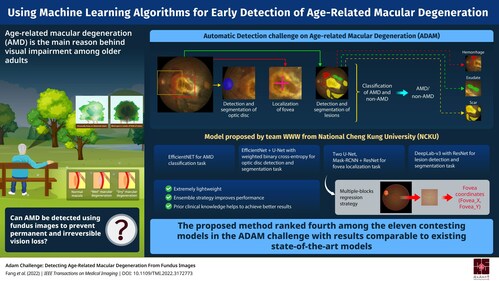TAINAN, Taiwan, Jan. 9, 2023 /PRNewswire/ — Vision loss is common among the elderly, and age-related macular degeneration (AMD) is one of the leading causes of vision loss. If left untreated, AMD can lead to permanent vision loss and irreversible damage to the retina.
The recent rise of machine learning (ML) in medical applications promises a quick and powerful solution for the early detection of AMD, which is essential for timely treatment. Fundus photography is a powerful tool that can be used to detect AMD; however, it is time-consuming and requires the expertise of a medical professional.
To this end, the Automatic Detection challenge on Age-related Macular degeneration or the ADAM challenge was set up as a satellite event of the ISBI 2020 conference. Eleven teams from all over the world participated in the challenge. The details of the challenge and its results were made available online in IEEE Transactions on Medical Imaging on May 4, 2022, and subsequently published in Volume 41 of the journal in October 2022. The team from National Cheng Kung University (NCKU), led by Dr. Chih-Chung Hsu, an Assistant Professor at the Institute of Data Science, NCKU, proposed the fourth-best ranking model for the ADAM challenge.
The challenge was broken down into four tasks addressing the critical aspects of detecting and characterizing AMD—AMD classification, optic disc detection and segmentation, fovea localization, and lesion detection and segmentation. A dataset of 1200 fundus images was made available for the challenge. The team from NCKU used four different ML architectures to address each task of the ADAM challenge.
For the first task, the team used an EfficientNet architecture for the binary classification of AMD. Then, for the optic disc detection and segmentation task, they used the EfficientNet architecture for classification combined with U-Net for segmentation with a weight cross-entropy loss function. For the fovea localization task, the team used a combination of two U-Net architectures, a Mask-RCNN and ResNet. And for the last task of lesion detection and segmentation, they used a DeepLab-v3 with Resnet.
Out of the four architectures used, the one used for fovea localization particularly stood out. The team used a multiple-blocks regression strategy to divide the fundus image into multiple blocks, after which each block was one-hot-encoded. “Early detection of AMD is essential for its treatment. We wanted to achieve a highly accurate symptom localization for fundus image, helping the doctors to have external references for their diagnosis,” says Dr. Hsu about the ML architecture.
The model proposed by the NCKU team was comparable in performance to other state-of-the-art models while being extremely lightweight. Additionally, the ensemble strategy employed improved the performance of the model and the use of prior clinical knowledge helped to achieve better results. “Given the fundus image, it is possible to diagnose AMD in a real-time sense, which might reduce the effort of doctors. Further, the proposed model can be integrated into hardware to be one of the standard pieces of equipment in any clinic. That would provide us with an AI-aided diagnosis, which could be very helpful for junior doctors or even interns,” concludes Dr. Hsu.
The team has made available a video describing the study.
Here’s looking forward to seeing this model in use in standardized equipment across hospitals and clinics soon!
Reference
Title of original paper: ADAM Challenge: Detecting Age-Related Macular Degeneration From Fundus Images
Journal: IEEE Transactions on Medical Imaging
DOI: https://doi.org/10.1109/TMI.2022.3172773
Media Contact:
Yu-Ting Chen
+886 6 2757575 ext. 80921
351570@email4pr.com
SOURCE National Cheng Kung University


